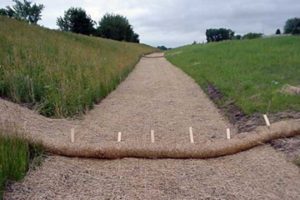Jute and Soil Erosion
Did you know that erosion is whittling the magnificent spires of Vermillion Cliffs National Park in Arizona?
Soil has an important part in history.
Like all empires, the Roman empire collapsed due to a number of reasons, not to forget their overloaded, exhausted, and depleted farmland which strained their ability to feed their people.
Here is an interesting read on what happened in history with soil erosion.
So in the modern times also, like in history, can nations go the Roman way – with its land and soil eroded, degraded, and depleted?
The fear of that possibility is very real.
Heat, animals, landslides, floods, fires, waves, crumbling rocks, wind, snow, rain, gushing water are all factors resulting in erosion.
Erosion is a natural phenomenon, it will continue to occur.
But human activity can make it worse and quicken the process. Whether by deforestation, where forests are cleared for commercial purposes or by use of environmentally harmful products on the fields that leave them barren.
The dangers of soil degradation has only increased from the overuse of agricultural chemicals like pesticides and fertilizers.
For more on soil erosion click on https://www.nrcs.usda.gov/wps/portal/nrcs/main/national/landuse/crops/erosion/
Like land and soil erosion, coastal erosion is another huge concern in the US.
Our oceans are a big force causing this. Shapes and outlines of beaches and sea-cliffs are changing at a faster pace than ever before. A case in example is The Outer Banks in North Carolina. In the US, in addition to beach erosion, tens of thousands of acres of coastal wetlands are unfortunately lost annually.
Another such dramatic coastal erosion has been witnessed in the Twelve Apostles Marine National Park in Victoria, Australia. Only eight apostles are now remaining, the ninth had collapsed in July 2005.
Soil erosion has many adverse impacts.
As the potential for climate change rises in the coming years, it becomes very crucial to make soil erosion assessments and take due steps to mitigate its’ impacts – on our landscapes, agriculture and environment.
Jute, a natural fiber, is helpful when it comes to preventing soil erosion. Let’s dig a bit deeper into jute and soil erosion.
Jute Netting to Prevent Soil Erosion
The most common and prevalent manner of preventing soil erosion from wind and water is by the use of mulch materials.
Mulch is used in conservation areas, banks, roadsides, neighborhoods, landscaping and plant production.
Straw and wood fibers have been used since long. In recent times, other natural, vegetable fibers like jute and coconut coir fibers are seeing an increase in usage.
These are all applied as a netting, mat or blanket.
Let’s see how and why jute is so safe and useful for prevention of soil damage.
Jute Products to Control Soil Erosion
Jute netting is a cool looking, earthy, mesh-woven product that is applied over mulch or directly used as a mulch.
Completely natural, the jute fibers can be easily woven in meshes that provide for an open area for plantation.
As seeds germinate, the seedlings emerge out of the netted meshes and grow.
Jute is a great mulch stabilizer when used on top of the mulch. Together they provide for a series of small impediments to water flow, thus controlling erosion.
Another product is the erosion control jute mat, made with straw, coconut fibers or wood chips in between jute layers.
You probably have seen these widely used in slopes, for aiding seed germination and for establishing vegetation. After the seeds are planted the erosion control mats are laid over the seeded area.
To install the netting or mat, work on the soil surface and remove debris, stones or rocks. Add fertilizer to the soil before adding the net, mat or mulch.
Ground staples should be used to anchor the nets and mats over the area. For placement on slopes, lots of staples should be used. Product manufacturers and distributors provide instructions on how to properly lay down the nets and anchor them.
Due to its biodegradable nature, jute slowly disintegrates in the soil and adds to the nutrient base. It could be anywhere from a year to upto two to three years for it to break down depending on the landform and weather conditions.
Jute is thus safe for environment, animals, pets, humans. It can be used in both residential and commercial sites, including our backyards.
Conclusion
Erosion can result in radical changes to ecosystems, changing landforms and impacting environment. It takes thousands of years to form topsoil.
Whether it is planting trees, or using environmentally-friendly products like jute, we all have our role to play when it comes to protecting our land, soil, coasts and earth. Let’s save our planet!

